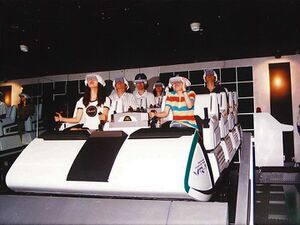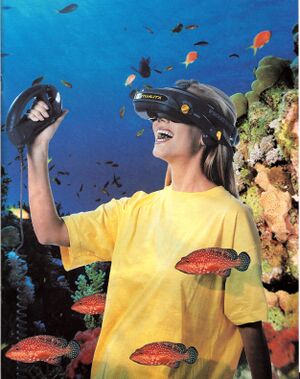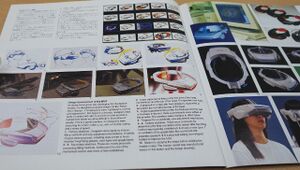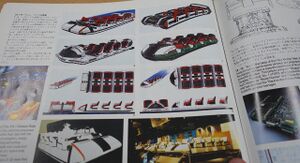Difference between revisions of "VR-1/History"
From Sega Retro
(AM4 lol) |
m (→Legacy) |
||
| Line 32: | Line 32: | ||
==Legacy== | ==Legacy== | ||
| − | The VR-1, and specifically its [[Mega Visor Display]], has been recognized as one of the most advanced pieces of virtual reality hardware of its generation.{{ref|https://web.archive.org/web/20200811132324/https://www.vrfocus.com/2020/07/the-virtual-arena-blast-from-the-past-the-vr-1/}} The MVD subsequently inspired the designs of several other examples, ensured Sega's reputation as an early [[wikipedia:virtual reality|virtual reality]] pioneer,{{ref|https://web.archive.org/web/20161004200031/https://www.gamebusiness.jp/article/2016/09/14/12597.html}} and set a benchmark not thought to have been surpassed until the late 2010s.{{ref|https://web.archive.org/web/20200811132324/https://www.vrfocus.com/2020/07/the-virtual-arena-blast-from-the-past-the-vr-1/}} | + | The VR-1, and specifically its [[Mega Visor Display]], has been recognized as one of the most advanced pieces of virtual reality hardware of its generation.{{ref|https://web.archive.org/web/20200811132324/https://www.vrfocus.com/2020/07/the-virtual-arena-blast-from-the-past-the-vr-1/}} The MVD subsequently inspired the designs of several other examples, ensured Sega's reputation as an early [[wikipedia:virtual reality|virtual reality]] pioneer,{{ref|https://web.archive.org/web/20161004200031/https://www.gamebusiness.jp/article/2016/09/14/12597.html}} and set a benchmark not thought to have been surpassed until the late 2010s.{{ref|https://web.archive.org/web/20200811132324/https://www.vrfocus.com/2020/07/the-virtual-arena-blast-from-the-past-the-vr-1/}} Virtuality's highly-publicised contract with Sega also saw other companies, including Namco, enlist their R&D knowhow.{{ref|https://web.archive.org/web/19970227165828/http://www.virtuality.com/docs/pac.htm}} |
The MVD's life after the release of VR-1 in 1994 was short; though it was successfully used as a design motif for the Virtuaroid characters of the ''Virtual-On'' series{{ref|https://web.archive.org/web/20161004200031/https://www.gamebusiness.jp/article/2016/09/14/12597.html}} (and was rumoured to be used for ''[[Cyber Troopers Virtual-On]]'' early on in development{{magref|gamest|148}}), the original arcade project that Sega and Virtuality intended to create, ''[[Dennou Senki Net Merc]]'', was met with a less positive response, and became the final release to use the headset after being produced in very low numbers.{{ref|1=https://web.archive.org/web/20210506212733/http://www.system16.com/hardware.php?id=712}} | The MVD's life after the release of VR-1 in 1994 was short; though it was successfully used as a design motif for the Virtuaroid characters of the ''Virtual-On'' series{{ref|https://web.archive.org/web/20161004200031/https://www.gamebusiness.jp/article/2016/09/14/12597.html}} (and was rumoured to be used for ''[[Cyber Troopers Virtual-On]]'' early on in development{{magref|gamest|148}}), the original arcade project that Sega and Virtuality intended to create, ''[[Dennou Senki Net Merc]]'', was met with a less positive response, and became the final release to use the headset after being produced in very low numbers.{{ref|1=https://web.archive.org/web/20210506212733/http://www.system16.com/hardware.php?id=712}} | ||
Revision as of 15:06, 2 June 2022
- Back to: VR-1.
Background
During the late 1980s and early 1990s, virtual realtiy technology experienced a boom in public interest around the world for the first time.[1] After early headset iterations used by organisations such as NASA and the popularisation of the VR term itself by Jaron Lanier during the previous decade,[2] the 90s saw a glut of new commercial VR hardware released to consumers and industry. One of the early beneficiaries of this boom was W. Industries' Virtuality Group, whose hit Virtuality 1000CS and 1000SD systems enticed arcades and out-of-home entertainment centres under the leadership of its original founder Dr. Jonathan Waldern.[1] Both would go on to be installed at a number of expositions and venues, including the popular Funland amusement centre situated in the London Trocadero entertainment complex and the unrelated Embracadero Center in San Fransisco.
Yet, in spite of virtual reality's acceptance and excitement among much of the public, criticism was sometimes made over the still-rudimentary graphics commercially provided to consumers at that time. Though the headsets available could simulate a stable virtual world, as a result of the use of hardware including the Amiga 3000, it would often be at noticeably low frame rates and resolutions, as well as using small counts of flat-shaded polygons to portray playing fields and objects.[1] In addition, the head-mounted displays used for VR were not believed to be ergonomically ideal for prolonged use, often using large, heavy designs to accommodate the size of the technology available at that time. These raised concerns about neck strain and hygiene, among other issues. After criticisms arose and new commercial technology failed to appear quickly, initial buzz around the technology slowly died down, though consumer interest in it would most often remain consistent throughout much of the 1990s.[1]
At the same time of VR's surge in popularity, Japanese video game and hardware developers Sega and Namco were involved in a notable rivalry over technological advancements. The companies had been competitors dating back to the earlier years of the coin-op amusement industry,[3] however this relationship was intensified by the rise of the "super-scaler" Taikan motion experience games popularised by Hang-On in the mid 80s. Namco imitated their appeal in titles including Metal Hawk, as well as establishing themselves at the cutting edge of 3D graphics with Winning Run. In what was perhaps the peak of their technological duel during 1990, Sega unveiled their rotational R360 arcade cabinet for super-scaler shooter G-LOC: Air Battle to the arcade market in a highly-publicised Shibuya press event,[4] while Namco dwarfed all previous releases in size considerably with the 28-player laserdisc-based Galaxian 3 ride attraction, at that time exclusively available for installation as an exhibition at expositions, such as Expo '90.[5] Though expensive, the two projects were received positively.
Additionally, both companies competed with each other in the amusement operations sector, opening progressively bigger family-oriented locations; Namco first held an upper hand, with the launch of Osaka's Plabo (featuring Virtuality pods and a cut-down 16-player version of Galaxian 3) in 1991,[6] and the first ever theme park opened by a video game company, Tokyo's Wonder Eggs, the following year, where the original Galaxian 3 installation was relocated.[7] Sega held similar plans and Disney-like aspirations, having already opened over 150 family-oriented Sega World amusement centers[3] and introduced a number of theme-park like attractions such as CCD Cart and Cyber Dome, but with the exception of confirmation of plans in October 1992[8] initially held back in the public eye.
Development
Unlike Namco, Sega had however shown more interest in producing their own virtual reality hardware, with Sega of America announcing the Sega VR during 1993.[9] Whilst this would ultimately go unreleased, its parent company in Japan would continue its own VR endeavours. In July 1993, W. Industries, owners of the Virtuality Group, won a £3.5 million contract[10] to collaborate with Sega's famed amusement research and development divisions on future releases.[11][12][13] Hayao Nakayama, then president of Sega, and Virtuality founder Jonathan Waldern were photographed together in the public announcement of the agreement, making the front page of the Game Machine coin-op trade paper and marking a significant moment for early relations between eastern and western VR developers.[14] At this stage, it was not yet specified which headset would be utilised as part of the agreement.[15]
According to initial reports, the original £3.5 million contract was solely for Virtuality to collaborate in development of a VR game for the Sega Model 1, at that time the most powerful arcade hardware on the market and a significant advancement on Namco's previous 3DCG efforts.[15] Because of its added prowess, it would allow the company to produce a cleaner looking and performing game experience than previous releases they had been involved in, as well as to provide a unique, high quality VR product to the industry.
The other area in which a significant improvement could be made was the ergonomic qualities of headsets; although standards had been slowly improving in that regard as a result of Virtuality's R&D efforts, no company had produced a generally satisfactory product yet. As a result, negotiations with Sega evolved to become higher-level, eventually involving the creation of a wholly new virtual reality headset and a centrepiece attraction for their planned theme parks, alongside the original arcade game agreement.
Collaboration between Virtuality and Sega would take place in the amusement R&D headquarters of the latter company in Japan, with two programmers (Andy Reece and Stephen Northcott) and two artists from the former company living in the country for a period.[16] The personnel undertook development on the original arcade project with AM3, aided with English translation liaison by Hisaki Nimiya,[17] although this project would not appear until a limited release in 1995 due to development issues and poor reception at event showcases.
At the same time, working towards the creation of a headset intended to set a VR benchmark, Virtuality also shared unique optics designs and patented technology with personnel from the hardware-focused AM4.[11] Numerous new iterations and versions were developed under tight secrecy to work out which types would work best in terms of ergonomic and graphical quality, some of which based on the advanced Visette headset.[11] Eventually, the designs were finalised and licenced, with the finished version christened the "Mega Visor Display".
For the creation of a larger project intended for the opening of a large flagship amusement facility in Yokohama during 1994, Sega's official theme park attraction development division, AM5, joined AM3, AM4, and Virtuality. This had been planned since late 1992 under the tentative name of "AS-1000",[18][19] using motion bases from the recently-released AS-1 simulator as a starting point.[20] Developers involved in aspects of VR-1 included AM3 programmer Kazunari Shimamura,[21] AM4 hardware designers Masao Yoshimoto, Masaki Matsuno, and Fujoshi Ito,[22] as well as AM5 engineers Shingo Yasumaru and Nobuyuki Takano.[20] Composer and sound designers including Keisuke Tsukahara[23] and Kazuhiko Nagai[24] also contributed. Despite the use of several examples of pre-existent technology, difficulties were still faced in development; synchronising the hardware and software proved to be a particular challenge, as at full capacity, 64 sets of boards would have to be ran for 32 riders, due to one board being used for each eye.[20]
Release
VR-1's first public installation was at Yokohama Joypolis, the first Joypolis indoor theme park, in July 1994.[25][20] Originally running the Space Mission experience, the ride was one of the premier features sited at the park on its opening day, debuting alongside two other newly-developed attractions by Sega (the non-virtual Mad Bazooka and Rail Chase: The Ride) and providing much of the basis for its main selling point of high-tech entertainment. It went on to become one of the more well received aspects of Sega's Amusement Theme Park concept, with a number of reviewers noting the Mega Visor Display's cut-down size and weight in comparison to other, more uncomfortable headsets available for public use at that time.[26][27]

In the following months, VR-1 was subsequently installed at a number of other indoor theme park venues opened by Sega in Japan, including further Joypolis branches in Niigata[28] and Fukuoka.[28] The original Yokohama installation received an update in 1995 to run new Planet Adventure software.[29] The attraction reappeared in 1996 and 1997, when its Space Mission incarnation was localised and installed outside of Japan at SegaWorld London and Sega World Sydney. Though claimed to be prone to breaking down frequently at these locations,[30] it again received praise in reviews.[31][32]
No further installations of VR-1 would ultimately occur, despite Sega's ambitions for a 100-strong chain of theme park locations across the world. After opening in December 1995, units were reported to be scheduled to eventually appear at the E-Zone Sega World arcade in Singapore alongside Mad Bazooka and Ghost Hunters to bring the center under the Amusement Theme Park concept in March 1996,[33] however this would not transpire. Before the creation of the GameWorks joint venture and chain of urban entertainment centers under a different concept, Sega intended virtual reality attractions of its type to feature as a premier attraction of its planned indoor theme parks in North America.[34][35]
In spite of VR-1's relative success, as well as some of the venues purportedly exceeding visitor number and revenue expectations,[36][37][38] Sega's detour into theme park entertainment had proved to be uneconomic by the end of the 1990s, with most of their Joypolis branches and two overseas Sega World parks either closed permanently or downsized in the midst of a restructuring in the company.[11] Due to this, as well as advancements in technology since its release, no VR-1 units remained in operation past 2001, and none are currently believed to exist in any form. Virtuality's contract with Sega appears to have been terminated in 1995, with the Dennou Senki Net Merc seeing a less positive reception and limited production due to shortages of Model 1 hardware.[16]
Legacy
The VR-1, and specifically its Mega Visor Display, has been recognized as one of the most advanced pieces of virtual reality hardware of its generation.[11] The MVD subsequently inspired the designs of several other examples, ensured Sega's reputation as an early virtual reality pioneer,[20] and set a benchmark not thought to have been surpassed until the late 2010s.[11] Virtuality's highly-publicised contract with Sega also saw other companies, including Namco, enlist their R&D knowhow.[39]
The MVD's life after the release of VR-1 in 1994 was short; though it was successfully used as a design motif for the Virtuaroid characters of the Virtual-On series[20] (and was rumoured to be used for Cyber Troopers Virtual-On early on in development[40]), the original arcade project that Sega and Virtuality intended to create, Dennou Senki Net Merc, was met with a less positive response, and became the final release to use the headset after being produced in very low numbers.[16]
Archival status
After the subsequent downsizing and closures of the venues that housed it during the late 1990s and early 2000s, there remain no known locations where the attraction remains in operation, and both its games are additionally unpreserved. Sega appear to hold at least one remaining Mega Visor Display headset, as well as a promotional booklet.[20]
References
- ↑ 1.0 1.1 1.2 1.3 https://www.vrs.org.uk/dr-jonathan-walden-virtuality-new-reality-promise-two-decades-soon/ (Wayback Machine: 2020-11-28 13:13)
- ↑ https://www.newscientist.com/article/mg21829226-000-virtual-reality-meet-founding-father-jaron-lanier/ (Wayback Machine: 2021-04-27 07:39)
- ↑ 3.0 3.1 http://shmuplations.com/akiranagai/
- ↑ Game Machine, "1990-08-01" (JP; 1990-08-01), page 1
- ↑ http://dengekionline.com/special/challenge/we/we01.html (Wayback Machine: 2019-04-24 04:17)
- ↑ Game Machine, "1991-11-15" (JP; 1991-11-15), page 14
- ↑ https://www.bandainamcoent.co.jp/corporate/history/namco/index.html (Wayback Machine: 2018-12-10 20:26)
- ↑ Game Machine, "1992-11-15" (JP; 1992-11-15), page 16
- ↑ Sega Force Mega, "August 1993" (UK; 1993-06-24), page 6
- ↑ Mega Power, "August 1993" (UK; 1993-07-29), page 8
- ↑ 11.0 11.1 11.2 11.3 11.4 11.5 https://www.vrfocus.com/2020/07/the-virtual-arena-blast-from-the-past-the-vr-1/ (Wayback Machine: 2020-08-11 13:23)
- ↑ Sega Force Mega, "October 1993" (UK; 1993-08-19), page 7
- ↑ Mega, "September 1993" (UK; 1993-08-19), page 7
- ↑ Game Machine, "1993-08-15" (JP; 1993-08-15), page 1
- ↑ 15.0 15.1 Game Machine, "1993-08-15" (JP; 1993-08-15), page 14
- ↑ 16.0 16.1 16.2 http://www.system16.com/hardware.php?id=712 (Wayback Machine: 2021-05-06 21:27)
- ↑ http://shmuplations.com/puzzlegamecreators/ (Wayback Machine: 2020-12-10 16:10)
- ↑ Arcade Game Magazine, "February 1996" (JP; 1996-01-09), page 54
- ↑ Famitsu, "1992-10-30" (JP; 1992-10-16), page 11
- ↑ 20.0 20.1 20.2 20.3 20.4 20.5 20.6 https://www.gamebusiness.jp/article/2016/09/14/12597.html (Wayback Machine: 2016-10-04 20:00)
- ↑ Arcade Game Magazine, "April 1996" (JP; 1996-02-29), page 98
- ↑ File:Patent_US5662523.pdf
- ↑ https://media.vgm.io/albums/86/4768/4768-1191149488.jpg (Wayback Machine: 2021-06-03 03:08)
- ↑ https://sbtransr02.wixsite.com/kazuhiko-nagai/my-works-1 (Wayback Machine: 2021-04-10 08:56)
- ↑ Beep! MegaDrive, "September 1994" (JP; 1994-08-08), page 24
- ↑ http://www.ibiblio.org/GameBytes/issue21/misc/joypolis.html (Wayback Machine: 2016-01-15 04:09)
- ↑ https://archive.org/details/sim_japan-times_august-08-14-1994_34_32/page/n9/
- ↑ 28.0 28.1 Sega Magazine, "1997-03 (1997-03)" (JP; 1997-02-13), page 20
- ↑ http://www.sega.co.jp/sega/atp/atc/vr1planeta.html (Wayback Machine: 1999-10-11 04:00)
- ↑ https://www.independent.co.uk/travel/outings-i-have-seen-the-future-of-fun-and-it-works-sort-of-1363207.html (Wayback Machine: 2021-05-25 21:25)
- ↑ https://archive.org/details/t-3-magazine-issue-1/page/n7/mode/2up
- ↑ Computer & Video Games, "November 1996 (Freeplay #7)" (UK; 1996-10-09), page 1
- ↑ Game Machine, "1995-09-01" (JP; 1995-09-01), page 14
- ↑ Press release: 1993-07-04:Sega Takes Aim at Disney's World
- ↑ https://techmonitor.ai/technology/sega_and_matsushita_subsidiary_in_theme_park_venture (Wayback Machine: 2021-05-29 23:52)
- ↑ File:Segaworld Trocadero '96 Promo Video.mp4
- ↑ https://archive.org/details/contemporarybusi00boon/page/184
- ↑ Game Machine, "1996-06-01" (JP; 1996-06-01), page 1
- ↑ http://www.virtuality.com/docs/pac.htm (Wayback Machine: 1997-02-27 16:58)
- ↑ Gamest, "1995-08-15" (JP; 1995-07-15)


